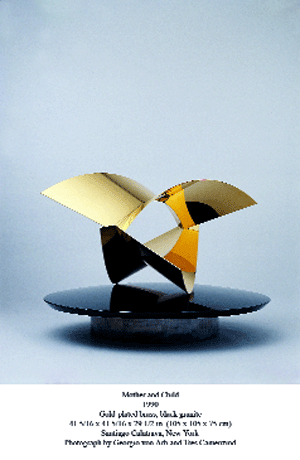Calatrava’s geometric forms swoop, leap, and shine with bravado, even kitschy machismo
At the Metropolitan Museum of Art to take a look at a new show of sculpture and architecture by Santiago Calatrava, whose most news-generating work is the transportation hub being built at the old World Trade Center site, I met the Spanish architect and got to ask him my Claes Oldenburg question.
It was based on a 1972 interview in which Oldenburg, that remaker of ordinary objects into giant Pop art, declared—“At the moment I am pretending to be an architect. I think that it is because the artist doesn’t have any real place in society that I assume a position that does have some reality, like an architect.”
The Met’s Calatrava show examines the borderland between the sculpture that he makes and his architecture. Of the 50 pieces on display, roughly half are sculpture. The rest are exquisitely finished building models, some of which have been realized, along with drawings and a computer-generated virtual tour of the Port Authority’s PATH terminal and transportation hub, designed by Calatrava and the firms STV and DMJM Harris. Work on it started at ground zero last month.
The show includes a model of the PATH structure, whose open core is overarched by giant interlocking wings that suggest angelic flight. Calatrava started as an engineer, and the wings will open when the weather permits. An exciting motorized set of the snow-white moving parts was in action at the Met, lifting and lowering.
Calatrava’s sculpture—surprise—is architectural. Geometric forms swoop, leap, and shine, generally, with a sort of bravado, a machismo that turned me off—not because a musky ego bothers me, but because these pieces project the kitschy gleam prized by Palm Springs decorators with wealthy clients. Some are made of gold-plated brass.
When I got to ask Calatrava whether he agreed with Oldenburg’s view of how sculpture and architecture differ in social status, he declared, “Claes Oldenburg!” Oldenburg turns out to be a Calatrava interest. “He’s right to make this point about functionality,” he said, but asserted that many sculptors—he named Richard Serra— “dream of being architects.
“Architecture is superior,” he said. “Because architecture can return you to yourself. It takes the ordinary events of peoples’ lives, fulfills them and transcends them.”
My sense was that he’d spoken to bury Pop’s long-lost New York irony, not to praise it.
gaycitynews.com



































